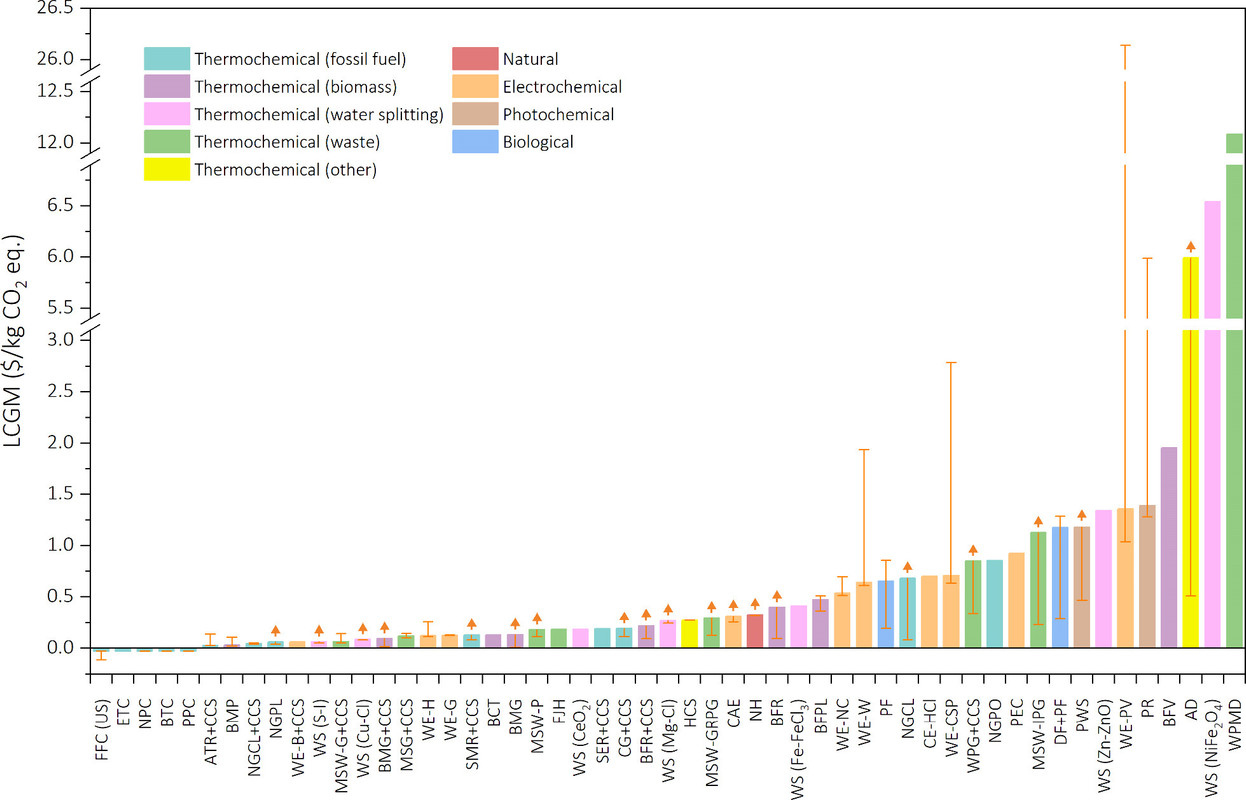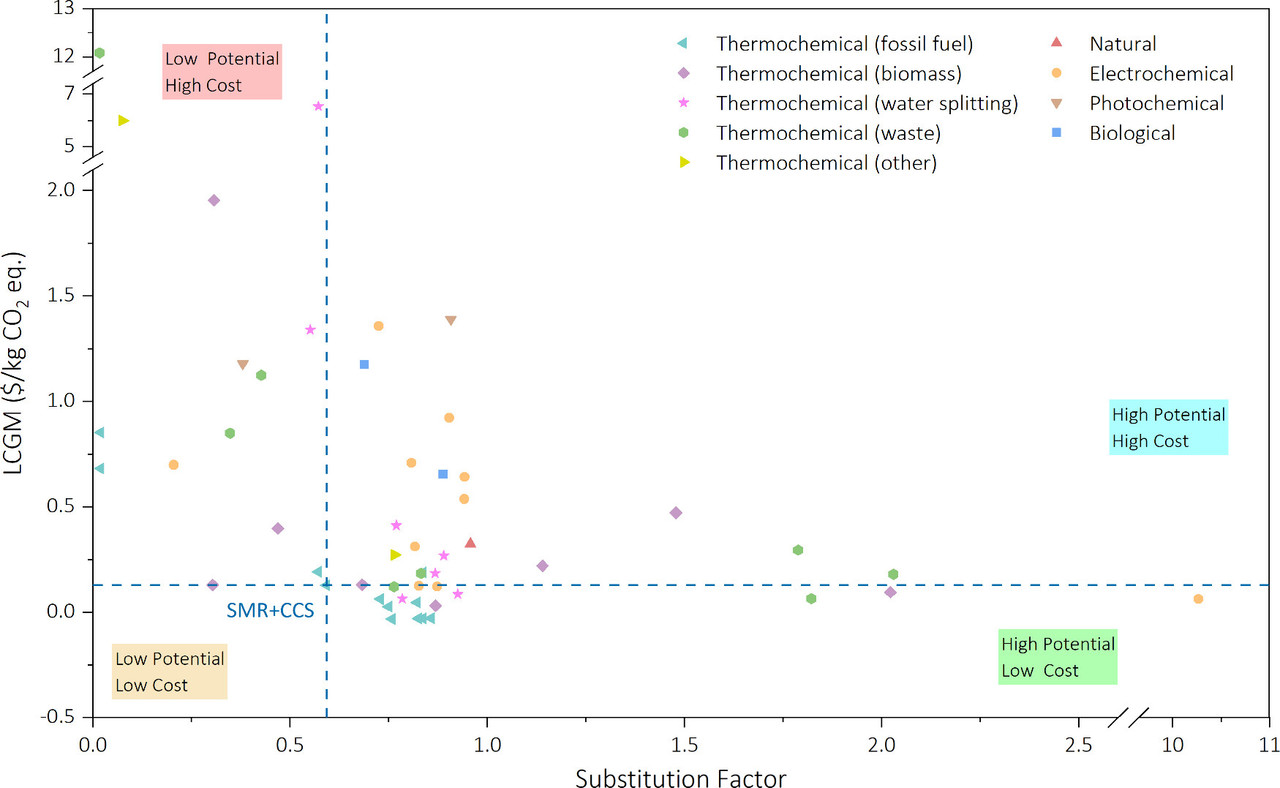Environment & Energy
Related: About this forumA fairly comprehensive review of the carbon cost of hydrogen production by various pathways.
We hear a lot of crap around here about "green hydrogen," handed out, in my opinion, by fossil fuel marketeers wishing to greenwash their product as well as wishful thinkers (and of course, rubes), all of whom wish to avoid the fact that there is no way to suspend physical laws, specifically, the laws of thermodynamics.
The paper I'll discuss in this post is this one: Life Cycle Greenhouse Gas Emissions and Mitigation Performances of Various Hydrogen Production Routes Lyu Zhang, Magnus Fröhling, Jingru Liu, Guangxin Liu, and Lei Shi Environmental Science & Technology 2025 59 (33), 17521-17533.
The paper (in the supplementary information) gives a pretty blunt assessment of the carbon cost for the overwhelmingly dominant route to hydrogen on this planet, the steam reformation of fossil fuels, and then waters them down with greenwashing nonsense about "CSS," carbon capture and storage.
I consider reference to "green hydrogen" to be an appalling lie, although I can credit "could be green" statements about hydrogen in the case where hydrogen is utilized as a captive intermediate, in the fuel case, as the starting material for DME, dimethyl ether, a wonder fuel that "could" (there's that word again) displace most of the world's fossil fuel for transport, heating, and act as a rather benign (if flammable) refrigerant. This approach could lead to a closed carbon cycle.
A closed carbon cycle, is very different, than a carbon dump, the above mentioned CSS, which like hydrogen itself, is an effort by the fossil fuel industry to greenwash itself. It is also true, albeit to a limited sense that carbon from the atmosphere can feasibly (particularly through the intermediary of seawater) that carbon can be effectively sequestered by use, that is to make products containing carbon, assuming these do not - as single use plastics do - create even more intractable environmental problems.
The bottom line about all of this is that hydrogen is not primary energy. It is not an energy source anywhere on this planet, nor is it really a "fuel" in a broad sense, although occasionally expensive stupid toys are advertised here to create the highly misleading - let's call it a "lie" - that there is an international trend toward the use of hydrogen as an energy carrier.
The horrible physical properties of hydrogen make this use, as a carrier is highly dubious, as the nation of South Korea recently learned by squandering oodles of money on the idea:
Korean Hydrogen Explosions, Leaks, Auction Failure & Impeachment May Cause Pivot
South Korea Scraps $414 Million Hydrogen Fuel Cell Power Project Due to Financial Strains
Note in the last case, the source of primary energy was not going to be the magical outbreak of a "renewable energy" nirvana that has not come, is not here, and won't come, although some was discussed as window dressing. The source was liquified natural gas. Natural gas is the dominant source of primary energy on the planet now, followed by coal, followed by petroleum (as a refining by product) followed by electrolysis, with most of the electricity coming by the combustion of dangerous fossil fuels, with the waste dumped directly into the planetary atmosphere without restraint, CSS bullshit not withstanding.
OK, let's turn to the paper cited at the outset. The introduction makes nice about hydrogen. I consider the first paragraph to border on complete nonsense because there is basically no evidence on any scale that matters that the statement I placed in bold below is even remotely true. It is not an energy source if - as must be the case - only primary energy can be considered a source.
If hydrogen is "recognized" as a source of energy, it is not so recognized by people aware of industrial practice, or the laws of thermodynamics.
As for what is generally euphemized as "Global climate change" commonly should, in my view, be referred to as "observed extreme global heating" and to be clear, the only thing that the use of hydrogen is doing with respect to it is to make it get worse faster. The 413 Mt figure is also misleading as stated. It refers to the cost of producing energy, not the cost of using energy.
As of 2023, the world release of carbon dioxide from fossil fuel combustion was about 37.6 billion tons:
Figures for carbon emissions can be obtained and used for calculations from the data here: Global Carbon Project at the link in data sets. The figures therein are reported as atomic carbon (Atomic Weight 12.011 g/mol) and I have corrected them for CO2 (Molecular Weight = 44.0095 g/mol) by applying the correction factor from the ratio, 3.644.
The authors do, however, in the next paragraph step back from their claim that hydrogen is free of climate impact, which is of course, the point of their otherwise fine paper. To wit:
This study is a metanalysis, not a primary report, and the authors intend to fill in some gaps. Above they note that the two of the three overwhelmingly prevalent fossil fuel based sources of hydrogen "steam methane reforming, (7) coal gasification," exist, leaving out hydrogen as a petroleum refining by product, that is in fact captively used in petroleum refining without much discharge for other uses.
The authors write:
In other words, in the part to which I've added bold, the missing element in these previous studies is that they focus mainly on what is being done, and do not consider laboratory benchtop "breakthroughs!!!!" as some people around here describe benchtop work without a whit of understanding the problem - often insurmountable - of going from the bench to even a pilot, never mind to a commercial industrial plant.
(A piece of advice: If you want to know why the planet is burning, consider the impulse to engage in handwaving in your ruminations.)
The authors write some defining terms in their paper:
The equations use as a base line, the MAJOR source of hydrogen on this planet, by far, despite all of the "green hydrogen" crap that's been flying around the world for the last 50 years while the planet gets hotter and ever more fiery. This is "SMR" steam methane reforming. (In China steam reforming of coal is also a major source of hydrogen.) This involves both the dangerous natural gas (or another dangerous fossil fuel) and, to generate steam, heat, the latter generated by the combustion of dangerous fossil fuels, generally methane. Thus the authors are quite reasonable in choosing SMR as the reference reaction.
To wit:


The point is that this is theory largely, not the existing state of industrial scale affairs. The reality is that for all the cartoonish videos posted here showing vast tracts of land industrialized for solar facilities - defined in the narcotic haze of public perception, erroneously in my view, as "green" - juxtaposed with some dangerous hydrogen bus, hydrogen car, hydrogen bicycle, hydrogen this and hydrogen that, the reality is that all this talk is nothing more than the greenwashing of dangerous fossil fuels, because, again, overwhelmingly, hydrogen is made from fossil fuels with exergy destruction, the wasting of energy.
Thus, every time one sees a hydrogen toy, one is seeing a device almost certain fueled by dangerous fossil fuels, requiring more dangerous fuels is if the device were run on dangerous fossil fuels directly.
Some graphics from the paper:

The caption:
Now let's cut to the chase and immediately reject any and all - there are multiple cases - involving, as mentioned above, "CSS" carbon capture and storage. Like hydrogen itself, CSS is nothing more than an effort to greenwash dangerous fossil fuels. There are, after decades of CSS bull, no industrial scale facilities for it. And let's be clear as to what that scale is:
Figures for carbon emissions can be obtained and used for calculations from the data here: Global Carbon Project at the link in data sets. The figures therein are reported as atomic carbon (Atomic Weight 12.011 g/mol) and I have corrected them for CO2 (Molecular Weight = 44.0095 g/mol) by applying the correction factor from the ratio, 3.644.
Pilot scale CSS plants, after having been run briefly for marketing/greenwashing purposes, have operated on a scale of millions of tons, not billions of tons.
The next graphic:

The caption:
I will refer briefly below to Table S2, which is huge, and gives the authors estimates, from their metanalysis, of the carbon cost of various, again, largely theoretical carbon costs of hydrogen.
In the title of this post I have used the word "fairly," because in my view, there is a huge omission, which has only passing reference in the paper: Nuclear driven thermochemical cycles. The passing reference is to just one of the chloride based cycles accessible from nuclear heat, the copper chlorine cycle, and the chloride cycles are, in turn, just a subset of the many thermochemical cycles available from nuclear heat in exergy recovery (process intensification) systems. The omission is further exacerbated by the fact that the copper chloride cycle, at least as I see it, is inherently a batch process, since it requires precipitation in multiple steps and drying in several. Thus it is not even an ideal thermochemical cycle since batch processes are inherently more expensive, and limited in volume and mass transfer, than are continuous cycles, which will involve fluid cycles, the best of which is one of the first to be popularized (by General Atomics, nearly 50 years ago), the sulfur iodine cycle.
All of the thermochemical cycles - and let's be clear that the SMR is a thermochemical open (not closed, as it rejects CO2 to the atmosphere) cycle - refer to either so called "renewable energy" or fossil fuels with the greenwashing fantasy of scaled CSS. Nuclear heat - if contemplated at all - appears under "other."
A graphic follow on economic costs expressed as the oft misused "LCOE" metric, which excludes, disastrously, the economic, environmental, and thermodynamic cost of intermittency, an unavoidable feature of so called "renewable energy" that has been ignored for its economic consequences, and thus accounts for the fact that people are still building dangerous fossil fuel plants despite all of the nonsense about solar and wind energy being "cheap."

The caption:
I don't much credit the final graphic in the paper, while conceding that as a metanalysis, the authors have seriously and honestly, I think, existing publications, the above omissions notwithstanding. An antinuke critic of mine here railed, after I dismissed as essentially meaningless, a breathless post about a battery "breakthrough" that I must be against "research." This is a rather dubious rhetorical leap, but one that I find unsurprising, given my low opinion of the intellectual depth of antinukes. As it happens however, two of the three members of my immediate family who are in academia, are involved with research teams, one of whom, my son, is on the front lines of energy research. I make this point since, to my mind, the following graphic does nothing more than indicate that more energy "research" is required. Of course, I support research. I'm a scientist.
The antinuke critic to whom I refer gloated - and I agree with him despite my general lack of respect for his "ideas" such as they are - that nuclear energy will not save the world. I consider that the time that nuclear energy might have saved the world passed probably about 40 years ago, the result of an unconscionable episode of selective attention that only preserved the status quo, the dominance of dangerous fossil fuels. The gloating amounts to the metaphor I often use to describe antinukes, "arsonists complaining about forest fires." The antinukes successfully - and let's be clear about this, they are happy to have done so - prevented the elimination of a fossil fuel dominated world with stupid focus on so called "nuclear wastes" and "costs" and "nuclear accidents." They did so without having exhibited the required shred of intellectual integrity to have noticed that they ignored the far more dangerous fossil fuel wastes, fossil fuel accidents, so widely prevalent that they almost seem "normal," and the cost of the collapse of the planetary atmosphere about which, in general, antinukes couldn't care less much beyond lip service.
The graphic, such as it is:

The caption:
All of the dots in this matrix can be moved, and others (for example a more comprehensive list of thermochemical cycles) can be added with, and only if, with research.
Nevertheless, no matter how much elegant research may follow in time, it is too late, to be sure, for nuclear energy to do what it might have done. The die is cast; the planet is burning; things are worsening faster and faster, day by day, hour by hour, second by second. This said, even if nuclear energy cannot solve the unsolvable, it is the best, a far superior, tool to do whatever can be done at this point. Nothing else can match it to address what can be addressed.
As for hydrogen, it is an essential tool for captive use, the asinine representations of this dangerous reagent as a consumer product not withstanding. It is not used widely or generally as fuel, nor should it be, but as a captive intermediate, it can and should play a role - only if produced by nuclear energy as a primary energy source of heat - in closing the anthropomorphic carbon cycle.
Closing the anthropomorphic carbon cycle should be, but isn't, the focus of research in energy although the idea has been around for a long time albeit with insufficient action. There probably isn't all that much hope for this happening, and certainly in the United States which is led by an ignorant orange pedophile with an intellectual level lower than even some of the antinukes around here, including hydrogen hyping antinukes.
Anthropogenic Chemical Carbon Cycle for a Sustainable Future George A. Olah, G. K. Surya Prakash, and Alain Goeppert Journal of the American Chemical Society 2011 133 (33), 12881-12898
Finally I would like to turn to Table S2 in the supplementary information, which unlike the paper itself, is likely to not be behind a firewall. (To find it, go to the link of the paper given at the outset, scroll down to "supplementary information," click on it, scroll down to see the document as an HTML file and, if interested, click on "download" to get a PDF.)
For convenience I will produce a graphic of a portion of the table, that referring to the most common approach for the production of hydrogen, the above discussed SMR, which again is the status quo, not some hyped "green hydrogen" nonsense the fossil fuel industry employs as a greenwashing tool. From these figures, with a little consideration, we can find out how much exergy is destroyed when we make hydrogen on this planet right now, not in some trivial hyped, and sometime trivially piloted, fantasy land. The portion of the table:

From this table we see that the median value for kilograms of methane needed to produce a kilogram of hydrogen is 10.91 kg CH4/kg H2.
For industrial thermodynamic calculation in practice we refer to the "high heating value" and "low heating value" of fuels. The former refers to the case where the water produced by combustion is liquified and brought to ambient temperatures, releasing heat in the process, the latter to the case most often encountered, where the steam combustion product is exhausted to the environment without recovering the heat of condensation. Thus we will refer to the low heating value, since this is the widely practiced scenario.
The low heating value of methane is 50 MJ/kg, of hydrogen 120 MJ/kg. Thus in the SMR it takes 10.91 kg * 50 MJ/kg = 545.5 MJ to produce 120 MJ of hydrogen. The energy loss per kg is thus 120 MJ - 545.5 MJ = -425.5 MJ. The minus sign refers to the fact that energy is wasted to make hydrogen. And that, my friends, is the real cost of all the hydrogen toys advertised here, this tiresome parade of buses, cars, helicopters, bicycles, blah, blah, blah advertised here with slick videos I suspect of being funded by the fossil fuel industry.
So much for "green hydrogen."
Have a nice weekend.